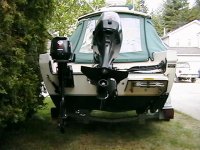Hello,
If you would permit, I would like to offer my opinion on a kicker for the CD 16 Cruiser. On C-Nile, I use a 4 HP, 4 Stroke, short-shaft Yamaha mounted on a Garelic kicker bracket. This Yamaha motor was the lightest 4-stroke, 4 HP motor in the world in 2007; it weighs only 48 pounds. The kicker bracket keeps the motor well out of the water when not in use. When I push the bracket down, it is well below the keel, but if I'm in very shallow water, leaving the kicker bracket up -- the bracket acts like a jack plate. Last year I got stuck in very shallow water, and got out with the kicker! As for speed, if I were to put a 6 HP motor on the transom, I doubt it would have much affect, because when one has insufficient horsepower to bring a boat onto plane, one really can't go much faster than hull speed. Also, I find that there is a miniscule difference in speed between full throttle on the kicker motor, and 1/4 throttle. It's hard to judge speed, but in my measurements with a GPS, I got between 4.8 and 5 MPH at full throttle. The nice thing about the Yamaha, is that it has an internal tank that gives you 40 minutes of run time, and also has an external tank option. As for placement, I put it on the port side in order to help offset my weight with my sitting on the starboard side. I had big problems with my main motor last year (fortunately it was just a wiring harness -- should have paid attention to Weifing's tech advice), which resulted in using my kicker to get back home 4 times! (The 5th time, I was too far way for the kicker and needed SeaTow.) I'll never have a boat without a kicker again. Lastly, to steer the boat with the kicker, I use the main engine as a rudder. It's not going to make quick turns, but it works. On the negative side of a kicker on the C-Dory 16, there are some things to be aware of:
1) The CD-16 stern does not take kindly to excessive weight. It can get stern heavy. It's manageable with the lesser weight of the Yamaha.
2) Even at 1/4 throttle, and even though the Yamaha 4HP is very quiet, we find the noise to be irritating -- it sort of permeates into the cabinet. My main motor (Suzuki), however, is whisper quiet under 7 knots.
3) Subjectively speaking, I think my mileage has dropped due to the extra drag of the stern weight. It would be interesting if others in the group concur with this observation.
Hope this helps,
Rich 8)


